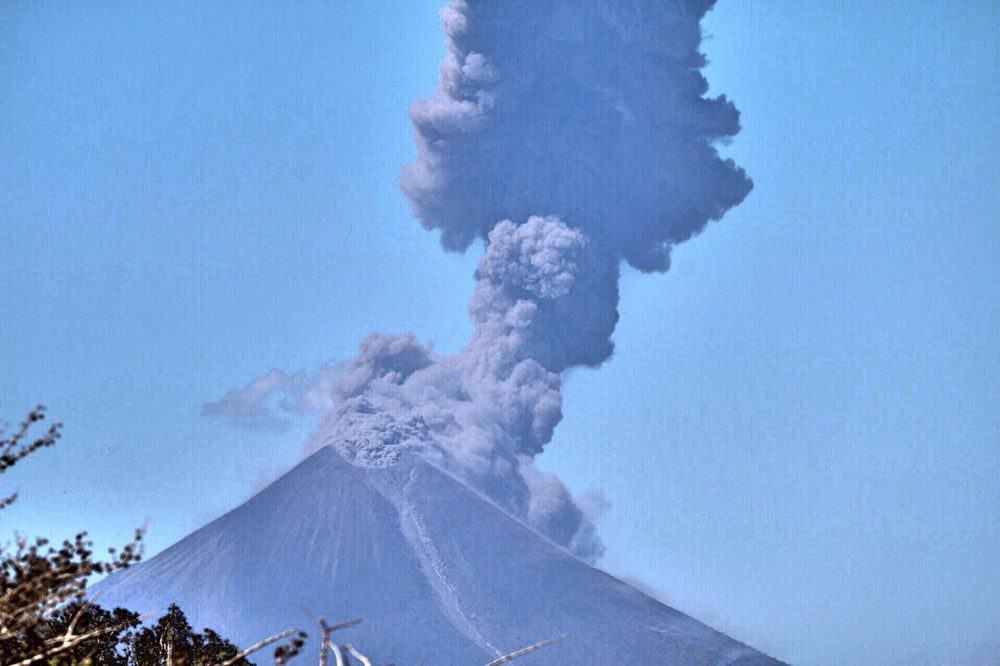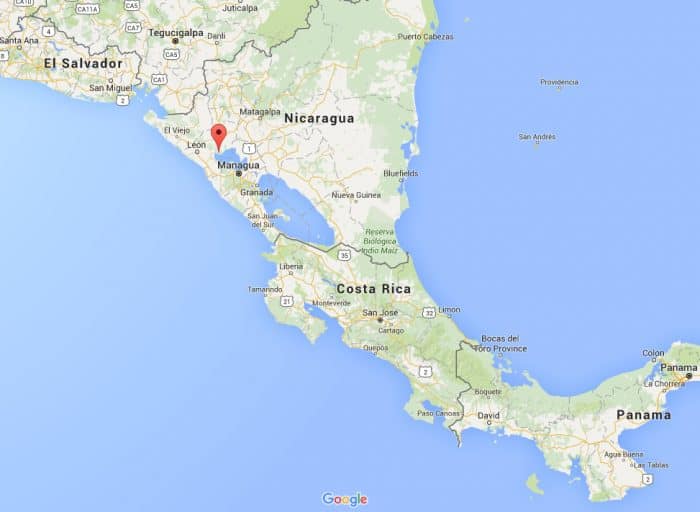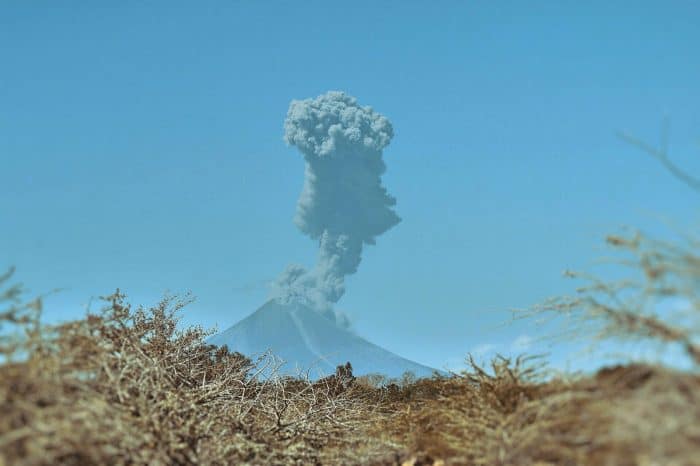Bulusan Volcano Erupts In Philippines
Cogon, Philippines2/22/2016
- Ernesto B. Gile Jr.
 14 hours ago
14 hours ago Bulusan Volcano nagbuga ng abo... https://t.co/Hv13x3KECk
Bulusan Volcano nagbuga ng abo... https://t.co/Hv13x3KECk - Bem Rosin
 14 hours agoMT. BULUSAN ERUPTED.. JUST NOW
14 hours agoMT. BULUSAN ERUPTED.. JUST NOW  /he's in so much pain that it caused him to explode, again.
/he's in so much pain that it caused him to explode, again.- Vivien ✖️
 15 hours ago
15 hours ago Bulusan Volcano with konting usok. 🌋 @ Irosin, Sorsogon City https://t.co/2f4k65cUIq
Bulusan Volcano with konting usok. 🌋 @ Irosin, Sorsogon City https://t.co/2f4k65cUIq - Chlouie Canaria
 15 hours ago
15 hours ago Current happening:Bulusan volcano nagbuga ng abo...huhuhu https://t.co/VCefXj5K5Y
Current happening:Bulusan volcano nagbuga ng abo...huhuhu https://t.co/VCefXj5K5Y
---------------------------------------------------------------------------------------------------------------------------------------
Nicaragua
PHOTOS: Nicaragua's Momotombo Volcano still putting on a show
The Tico Times and AFP 3 hours ago
Nicaragua's Momotombo Volcano continues to erupt after a century of inactivity, on Sunday, Feb. 21, 2016.
Álvaro Sánchez/The Tico Times
By all appearances, Nicaragua's formerly sleeping giant Momotombo ain't going back to bed just yet.
The picturesque stratovolcano, located near the city of León, continued erupting Sunday morning when these pictures were taken. Momotombo, on the northern edge of Lake Managua, about 40 kilometers northwest of Nicaragua's capital, erupted for the first time in 110 years on Dec. 1, 2015, sending geologists and local townspeople into a tizzy. In fact, there's been so much volcanic and seismic activity in Nicaragua lately that experts from the United States, the United Kingdom, Nicaragua and Costa Rica are carefully studying and observing the situation.

(Google Maps)
According to the AFP, citing Nicaragua government spokeswoman and first lady Rosario Murillo, geologists from the U.S. Geological Survey and other institutions announced last week that they are studying and assessing risks from Momotombo and other active volcanoes in the country, including Télica and Masaya. In an unexpected and simultaneous event, Momotombo, Télica and Masaya began eruptive processes at about the same time, and another location, Cerro Negro, experienced ongoing seismic activity last week.

Nicaragua's Momotombo Volcano continues to erupt after a century of inactivity, on Sunday, Feb. 21, 2016.
Álvaro Sánchez/The Tico Times
To date, the 1,297-meter-tall Momotombo hasn't placed any nearby residents in danger, but that's not to say it couldn't. In 1610, a Momotombo eruption forced residents of the then-Spanish city of León to relocate 50 km to the west.
"The danger of this seismic activity is because it's from Plinian eruptions, which are characterized by a high level of explosiveness," Nicaragua's Seismology Network said in a statement. Plinian eruptions are the largest of all types of volcanic eruptions.
https://www.ticotimes.net/2016/02/22/photos-nicaraguas-momotombo-volcano-still-putting-on-a-show-----------------------------------------------------------------------------------------------------------------------------------
Taking on the world's most dangerous volcano, see how
All photos courtesy: Mark Robinson.
Digital Reporter
Monday, February 22, 2016, 4:31 PM - The total drop distance from the rim of the boiling, hissing cauldron of molten rock known as the Nyiragongo volcano to the shore of the lava lake deep inside the crater:
Five hundred metres.
And I was leaning just far enough back in my harness that I could see the entire dizzying drop from a crumbling edge.
![]() SPRING IS HERE: How will El Niño affect your spring? Find out on The Weather Network's Spring Forecast. Premiering February 29, 2016, at 9PM ET #SpringForecast
SPRING IS HERE: How will El Niño affect your spring? Find out on The Weather Network's Spring Forecast. Premiering February 29, 2016, at 9PM ET #SpringForecast
Meteorology classes never prepared me for this
Nyiragongo is a cone volcano that dominates the sky above the city of Goma, located in the Democratic Republic of Congo, in eastern Africa. It's an active mountain that erupted in 2002; with the resulting lava flow destroying a large area of Goma and nearly shutting down the airport.
Helping prevent another disaster was part of why we – myself and George Kourounis - were in one of the planet's most-volatile locales.
Nyiragongo is dangerous
The volcano is what is known as an effusive (as opposed to explosive) type which means that the lava produced is very liquid and is constantly erupting within the crater. Thus, gas pressure never builds up enough to create a Mount St. Helens type of explosion. However, this doesn't make it less dangerous. Instead, the volcano's danger comes from the potential for very liquid lava to suddenly emerge from fissures on the flanks of the mountain very close to, or in Goma. The fluid nature of the molten rock means that it can travel at speeds approaching 100 km/h on a steep slope. That's very difficult to get out of the way of if there's no warning.
Given the lack of modern infrastructure and communications, getting a warning out to the city as well as even attempting an evacuation would be an exercise in futility. Most of the roads are dirt, pitted with massive rocks that slow car travel down to crawl even if there wasn't hundreds of motorcycles and pedestrians all attempting to use the narrow laneways all at once. Traffic signals, stop signs, etc., simply don't exist in the city and only a few major roads are paved to any significant extent. The city is a disaster-in-waiting that many fear will be played out sooner than later.
One goal was to get down to the edge of the lava and document the largest lava lake in the world, and the second goal was to get the scientists from the Goma Volcano Observatory into the volcano so that they could collect data and determine the level of activity within the mountain. Despite the danger of the mountain, very few observations and studies have been done, mostly due to lack of funding.
Getting to the edge of the lava lake wasn't going to be easy
Simple, yes, easy, no. Geoff Mackley, expedition leader, along with his team of Bradley Ambrose and Chris Horsley determined the best route down would be a 200 metres drop from the rim of the caldera to a small ledge; from there, a second rope would drop another 150 metres to a much larger ash plain/ledge before a final drop of about 150 metres to the final ledge surrounding the lava lake itself.
After a day of rigging and determining the exact routes, I clipped myself into the ropes, ran a secondary safety system and prepared to make the drop into the unknown along with Kourounis. We'd be running parallel to each other in order to ensure my safely. George had done this kind of thing a few times before so I figured I was likely in good hands. The ledge was crumbling beneath my feet as I leaned back into the harness and let the rigging system take my weight. It was a moment that I had been dreading. This was when I figured I'd either start crying or running. What I didn't expect was the total exhilaration of being suspended over empty space while volcanic gases swirled around me. I had total confidence in both the rigging and the team. I was going to drop into a place that few humans had ever been.
Ok, it was less a drop and more of a very, very steep walk backwards down one of the crumbliest cliff faces I'd ever seen. Every few steps, rocks would shift under my feet and plunge towards the ground far below. The crack, snap of them hitting the sides of the cliff sounded like distant gunfire and I was reminded that large rocks could cut right through the climbing ropes. I got very careful about where I put my feet.
Rock falls are the biggest danger in climbing or rappelling
Falls are very rare and are usually caused by operator error. Rocks on the other hand, can strike without warning and even small ones can cause serious injury. Bradley Ambrose, one of the others on the team had a very close call when a rock missed his leg by about ten centimeters and bashed a huge dent in his aluminum water bottle. He hadn't even heard it fall from far above.
If you have warning time, because you've heard the rock strike the cliff further up or heard one of your teammates call out "Rock!", the best (and usually only) thing you can do is get as close to the cliff face as possible and pull your limbs in close. All climbers wear helmets to minimize the damage to your skull a falling rock can do, but even then, it's extraordinarily dangerous.
Steam boiled off the cliff face here and there and when I arrived at a particularly abundant area, the damp air soaked through my clothes and I knew that this wasn't a quick rock climb on the Niagara Escarpment in Ontario. Steam vents are cracks in the volcanic rock where rainwater, after trickling downwards through the mountain, had turned to steam and boiled back up through the volcano. And they were everywhere, speaking loudly of the true power of the volcano – the molten rock at the heart of it.
I dropped to the ground of the first ledge, exhausted and soaked with sweat and steam. Another 100 metres to go to get to the first real stopping point, the great ash plain before the final drop. Kourounis swiftly unclipped both him and myself and then snapped me into the next set of lines. Only this time, I'd be going it alone. No tandem drop, just me on my own.
Hmm, ok. Nevermind the winds gusting past us now, nevermind the volcanic gases (sulphur dioxide – smells like a struck match – hydrogen sulphide – smells like rotten eggs. Both deadly to humans), nevermind that I'd never made a drop like this one.
Just me and a sheer drop into the bottom of an active volcano that could, at any moment, shudder into life and shake us off the side of it like a horse shrugging off a blackfly.
And meteorologists can't fly…
Part II, III and a stunning photo gallery of Mark Robinson and George Kourounis' death-defying descent in to Mount Nyiragongo will be published in the coming weeks.
http://www.theweathernetwork.com/news/articles/taking-on-the-worlds-most-dangerous-volcano/64028
-------------------------------------------------------------------------------------------------------------------------------------
Volcanic activity worldwide 22 Feb 2016: Colima volcano, Alaid, Momotombo
Alaid (Northern Kuriles): New thermal anomalies have been detected from the volcano during the past days via satellite data. It is not known whether or not a new eruption is underway at the volcano which is rarely visited, but one of the most active ones in the area.
Its most recent eruption from Oct 2015 to January this year produced spectacular lava flows that flowed into the sea and enlarged the uninhabited island.
The Aviation Color Code was raised again to yellow.
Colima (Western Mexico): As had been suspected last week, a new (still small) lava dome has appeared inside the volcano's summit crater. During an overflight on 19 Feb, it was seen to be approx. 25 m in diameter and 10 m tall.
Momotombo (Nicaragua): Activity has been a bit quieter over the past days, but the volcano continues to produce a few (on average two per day) mild to moderate explosions.
Volcano Activity Summary for 22 Feb 2016:
Currently erupting:
Ambrym (Vanuatu): active lava lakes in several craters (updated 18 Feb 2016)Aso (central Kyushu, Japan): steaming, occasional phreatomagmatic or strombolian explosions (updated 26 Oct 2015)
Bagana (Bougainville Island, Papua New Guinea): mild ash emissions (updated 26 Oct 2015)
Batu Tara (Sunda Islands, Indonesia): strombolian explosions, ash plumes up to 500 m, extrusion of a small lava dome with rockfalls (updated 28 Nov 2015)
Bromo (East Java, Indonesia): intermittent ash-rich explosions, ash venting (updated 8 Feb 2016)
Colima (Western Mexico): intermittent vulcanian explosions (updated 22 Feb 2016)
Cotopaxi (Ecuador): vulcanian explosions (updated 16 Aug 2015)
Dukono (Halmahera): mild strombolian activity, continuous intense ash emissions (updated 14 Feb 2016)
Erebus (Antarctica): active lava lake in summit crater (updated 8 Dec 2014)
Erta Ale (Danakil depression, Ethiopia): overflowing lava lake (updated 18 Jan 2016)
Fuego (Guatemala): lava flows on S and W flanks, lava fountaining from summit vent (updated 10 Feb 2016)
Ibu (Halmahera, Indonesia): stromolian and phreatomagmatic explosions (updated 29 Oct 2015)
Karymsky (Kamchatka): occasional small explosions, thermal anomaly (updated 10 Feb 2016)
Kilauea (Hawai'i): new lava flow from vents on NE flank of Pu'u 'O'o (updated 28 Apr 2015)
Kliuchevskoi (Kamchatka): ash emissions, weak strombolian activity (updated 11 May 2015)
Manam (Papua New Guinea): large explosion on 31 July 2015 (updated 31 Aug 2015)
Masaya (Nicaragua): active lava lake in summit crater since mid Dec 2015 (updated 16 Feb 2016)
Momotombo (Nicaragua): intermittent vulcanian explosions (updated 22 Feb 2016)
Nevado del Ruiz (Colombia): intermittent ash emissions, strong degassing (updated 21 Sep 2015)
Nyiragongo (DRCongo): active lava lake in summit crater (updated 26 Feb 2014)
Ol Doinyo Lengai (Tanzania): effusion of natrocarbonatite lava inside the crater (updated 8 Jul 2013)
Pacaya (Guatemala): intense spattering from intra-crater cone (updated 13 Jan 2016)
Popocatépetl (Central Mexico): degassing, sporadic explosions, slowly growing lava dome (updated 18 Feb 2016)
Rabaul (Tavurvur) (New Britain, Papua New Guinea): lava fountains, ash emissions from Tavurvur cone (updated 12 Sep 2014)
Reventador (Ecuador): lava flow on SW flank (updated 17 Aug 2015)
Sakurajima (Kyushu, Japan): seismic swarm, eruption warning (updated 12 Feb 2016)
Sangay (Ecuador): likely strombolian eruptions at summit crater (updated 13 Mar 2015)
Santiaguito (Guatemala): intermittent explosions from Caliente dome, strong degassing (updated 5 Feb 2016)
Semeru (East Java, Indonesia): growing lava dome, lava flow, strombolian activity (updated 14 Feb 2016)
Shiveluch (Kamchatka): growing lava dome (updated 29 Jan 2016)
Sinabung (Sumatra, Indonesia): continuing pyroclastic flows (updated 14 Feb 2016)
Soputan (North Sulawesi, Indonesia): strong eruption 4-6 Jan 2016 (updated 6 Feb 2016)
Stromboli (Eolian Islands, Italy): weak strombolian activity at summit vents (updated 16 Apr 2015)
Suwanose-jima (Ryukyu Islands): strombolian explosions in Ontake crater (updated 1 Oct 2015)
Tungurahua (Ecuador): intermittent small ash emissions, small to moderate explosions (updated 21 Nov 2015)
Ubinas (Peru): sporadic vulcanian explosions (updated 16 Jan 2016)
Villarrica (Central Chile): small lava lake in summit crater (updated 12 May 2015)
Yasur (Tanna Island, Vanuatu): ash emissions, weak strombolian explosions (updated 13 Nov 2015)
Zhupanovsky (Kamchatka, Russia): occasional explosions and ash emissions (updated 14 Feb 2016)
Eruption warning / minor activity:
Asama (Honshu): occasional small explosions since 16 June 2015 (updated 22 Jun 2015)Augustine (Cook Inlet (SW Alaska))
Barren Island (Indian Ocean): weak thermal hot spot (updated 3 Feb 2016)
Bezymianny (Central Kamchatka Depression): steaming, weak seismic activity (updated 3 Jul 2014)
Bulusan (Luzon Island, Philippines): occasional phreatic explosions (updated 16 Jun 2015)
Canlaon (Central Philippines): occasional phreatic explosions (updated 11 Dec 2015)
Cerro Negro (Nicaragua): increased earthquake activity (updated 16 Feb 2016)
Chirinkotan (Northern Kuriles, Russia): sporadic ash emissions (updated 28 Jul 2015)
Copahue (Chile/Argentina): seismic unrest, occasional ash venting (updated 3 Feb 2016)
Etna (Sicily, Italy): weak strombolian activity inside Voragine crater (updated 19 Apr 2014)
Heard (Australia, Southern Indian Ocean): strombolian activity, lava flow from Mawson Peak summit crater (updated 1 Feb 2016)
Karangetang (Siau Island, Sangihe Islands, Indonesia): rockfalls, glowing lava dome (updated 13 Jan 2016)
Kavachi (Solomon Islands): no eruption since 2007 (updated 16 Jun 2014)
Kerinci (Sumatra): seismic unrest, steam emissions (updated 5 Jun 2013)
Kick 'em Jenny (West Indies, Grenada): volcanic unrest, eruption warning (updated 24 Jul 2015)
Krakatau (Sunda Strait, Indonesia): steaming, seismic unrest (updated 15 Nov 2015)
Kuchinoerabu-jima (Ryukyu Islands): large explosive eruption on 29 May 2015 (updated 27 Mar 2015)
Lascar (Northern Chile): sudden explosion on 30 Oct 2015 (updated 31 Oct 2015)
Lopevi (Vanuatu): eruption warning (updated 16 Dec 2014)
MacDonald (Austral Islands, ): steaming observed (updated 6 Feb 2016)
Mayon (Luzon Island, Philippines): steaming (updated 18 Dec 2014)
Merapi (Central Java, Indonesia): sporadic phreatic explosions (updated 21 Aug 2015)
Michael (United Kingdom, South Sandwich Is): unspecified activity detected as hot spot on satellite data (updated 3 Oct 2015)
Nevados de Chillán (Central Chile): short ash emission on 8 Jan 2016 (updated 1 Feb 2016)
Nyamuragira (DRCongo): active lava lake (updated 29 Nov 2014)
Ontake-san (Honshu): steaming, low seismic activity (updated 18 Dec 2014)
Papandayan (West Java): steaming (updated 6 May 2013)
Pavlof (Alaska Peninsula, USA): steaming, elevated seismic activity (updated 22 Dec 2014)
Poas (Costa Rica): phreatic explosions (updated 14 Oct 2014)
Rasshua (Central Kuriles)
Raung (East Java): intra-caldera eruption with lava flow and strombolian activity (updated 27 Aug 2015)
Rincón de la Vieja (Costa Rica): phreatic explosions from crater lake (updated 21 Sep 2014)
Sabancaya (Peru): steaming, elevated seismic activity (updated 11 Oct 2015)
Sacabaya (Northern Chile, Bolivia and Argentina)
San Cristobal (Nicaragua): possible ash emission on 11 April (updated 9 Mar 2015)
San Miguel (El Salvador): intermittent ash emissions (updated 15 Jan 2016)
Sangeang Api (Indonesia): weak lava extrusion from summit crater (updated 11 Nov 2015)
Sirung (Pantar Island, Indonesia ): degassing (updated 10 Jul 2015)
Slamet (Central Java): steam emissions (updated 12 Jan 2015)
Telica (Nicaragua): degassing (updated 16 Feb 2016)
Turrialba (Costa Rica): sporadic ash emissions, weak crater glow (updated 3 Feb 2016)
Ulawun (New Britain, Papua New Guinea): degassing, ash venting (updated 5 Aug 2013)
http://www.volcanodiscovery.com/volcano-activity/news/56518/Volcanic-activity-worldwide-22-Feb-2016-Colima-volcano-Alaid-Momotombo.html
--
__._,_.___
 Comment
Comment Email
Email
No comments:
Post a Comment